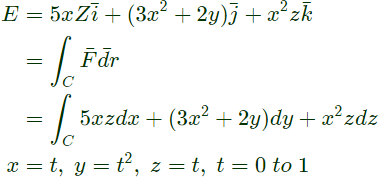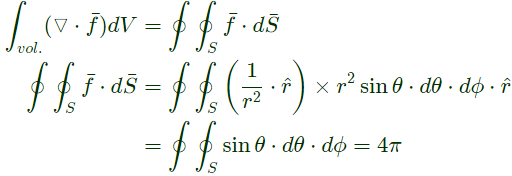Q1: In the (x, y, z) coordinate system, three point-charges Q, Q and αQ are located in free space at (−1, 0, 0), (1, 0, 0) and (0, −1, 0) respectively. The value of α for the electric field to be zero at (0, 0.5, 0) is _____ (rounded off to 1 decimal places). (2024)
(a) -1.61
(b) -2.36
(c) -2.87
(d) -3.25
Ans: (a)
Sol:  From the figure,
From the figure,

Q2: In the figure, the electric field E and the magnetic field B point to x and z directions, respectively, and have constant magnitudes. A positive charge 'q' is released from rest at the origin. Which of the following statement(s) is/ are true. (2023)
 (a) The charge will move in the direction of z with constant velocity.
(a) The charge will move in the direction of z with constant velocity.
(b) The charge will al ways move on the y-z plane only.
(c) The trajectory of the charge will be a cycle.
(d) The charge will progress in the direction of y.
Ans: (a)
Q3: The vector function expressed by
 represents a conservative field, where ax, ay, az are unit vectors along x, y and z directions, respectively. The values of constants k1, k2, k3 are given by: (2020)
represents a conservative field, where ax, ay, az are unit vectors along x, y and z directions, respectively. The values of constants k1, k2, k3 are given by: (2020)
(a) k1 = 3, k2 = 3, k3 = 7
(b) k1 = 3, k2 = 8, k3 = 5
(c) k1 = 4, k2 = 5, k3 = 3
(d) k1= 0, k2 = 0, k3 = 0
Ans: (c)
Sol: 



Q4: The figures show diagrammatic representations of vector fields  respectively. Which one of the following choices is true? (SET-2 (2017))
respectively. Which one of the following choices is true? (SET-2 (2017))
 (a)
(a) 
(b) 
(c) 
(d) 
Ans: (c)
Sol: 
Q5: The line integral of the vector field  along a path from (0, 0, 0) to (1, 1, 1) parametrized by (t, t2, t) is _____. (SET-2 (2016))
along a path from (0, 0, 0) to (1, 1, 1) parametrized by (t, t2, t) is _____. (SET-2 (2016))
(a) 4.41
(b) 2.26
(c) 6.56
(d) 8.34
Ans: (a)
Sol: 

Q6: In cylindrical coordinate system, the potential produced by a uniform ring charge is given by ψ = f(r, z), where f is a continuous function of r and z. Let  be the resulting electric field. Then the magnitude of
be the resulting electric field. Then the magnitude of  (SET-1 (2016))
(SET-1 (2016))
(a) increases with r.
(b) is 0.
(c) is 3.
(d) decreases with z.
Ans: (b)
Sol: V is given as static field in time invariant.
Hence, ▽ × E = 0
Q7: Match the following. (SET-2 (2015))
 (a) P-2 Q-1 R-4 S-3
(a) P-2 Q-1 R-4 S-3
(b) P-4 Q-1 R-3 S-2
(c) P-4 Q-3 R-1 S-2
(d) P-3 Q-4 R-2 S-1
Ans: (b)
Sol: Stokes theorem 
Gauss theorem 
Divergence theorem
Cauchy integral theorem
Q8: Consider a function  where r is the distance from the origin and
where r is the distance from the origin and  is the unit vector in the radial direction. The divergence of this function over a sphere of radius R, which includes the origin, is (SET-1 (2015))
is the unit vector in the radial direction. The divergence of this function over a sphere of radius R, which includes the origin, is (SET-1 (2015))
(a) 0
(b) 2π
(c) 4π
(d) Rπ
Ans: (c)
Sol:  From divergence theorem as we know,
From divergence theorem as we know,

Q9: The direction of vector A is radially outward from the origin, with ∣A∣ = krn, where r2 = x2 + y2 + z2 and k is a constant. The value of n for which ▽⋅A = 0 is (2012)
(a) -2
(b) 2
(c) 1
(d) 0
Ans: (a)
Sol: 

Q10: Divergence of the vector field
 is (2007)
is (2007)
(a) 2z cos z2
(b) sinxy + 2z cos z2
(c) xsinxy − cosz
(d) None of these
Ans: (a)
Sol: 

Divergence 

Q11: Consider the following statements with reference to the equation (δp/δt)
- This is a point form of the continuity equation.
- Divergence of current density is equal to the decrease of charge per unit volume per unit at every point.
- This is Max well's divergence equation
- This represents the conservation of charge
Select the correct answer. (2006)
(a) Only 2 and 4 are true
(b) 1, 2 and 3 are true
(c) 2, 3 and 4 are true
(d) 1, 2 and 4 are true
Ans: (d)
Q12: If  is the electric intensity,
is the electric intensity,  is equal to (2005)
is equal to (2005)
(a) 
(b) 
(c) null vector
(d) Zero
Ans: (d)
Sol: Divergence of a curl field is always zero.
i.e. 
Q13: Given a vector field  the divergence theorem states that (2002)
the divergence theorem states that (2002)
(a) 
(b) 
(c) 
(d) 
Ans: (a)
 From the figure,
From the figure,
 (a) The charge will move in the direction of z with constant velocity.
(a) The charge will move in the direction of z with constant velocity. represents a conservative field, where ax, ay, az are unit vectors along x, y and z directions, respectively. The values of constants k1, k2, k3 are given by: (2020)
represents a conservative field, where ax, ay, az are unit vectors along x, y and z directions, respectively. The values of constants k1, k2, k3 are given by: (2020)



 respectively. Which one of the following choices is true? (SET-2 (2017))
respectively. Which one of the following choices is true? (SET-2 (2017)) (a)
(a) 




 along a path from (0, 0, 0) to (1, 1, 1) parametrized by (t, t2, t) is _____. (SET-2 (2016))
along a path from (0, 0, 0) to (1, 1, 1) parametrized by (t, t2, t) is _____. (SET-2 (2016))

 be the resulting electric field. Then the magnitude of
be the resulting electric field. Then the magnitude of  (SET-1 (2016))
(SET-1 (2016)) (a) P-2 Q-1 R-4 S-3
(a) P-2 Q-1 R-4 S-3



 where r is the distance from the origin and
where r is the distance from the origin and  is the unit vector in the radial direction. The divergence of this function over a sphere of radius R, which includes the origin, is (SET-1 (2015))
is the unit vector in the radial direction. The divergence of this function over a sphere of radius R, which includes the origin, is (SET-1 (2015)) From divergence theorem as we know,
From divergence theorem as we know,


 is (2007)
is (2007)



 is the electric intensity,
is the electric intensity,  is equal to (2005)
is equal to (2005)


 the divergence theorem states that (2002)
the divergence theorem states that (2002)





























